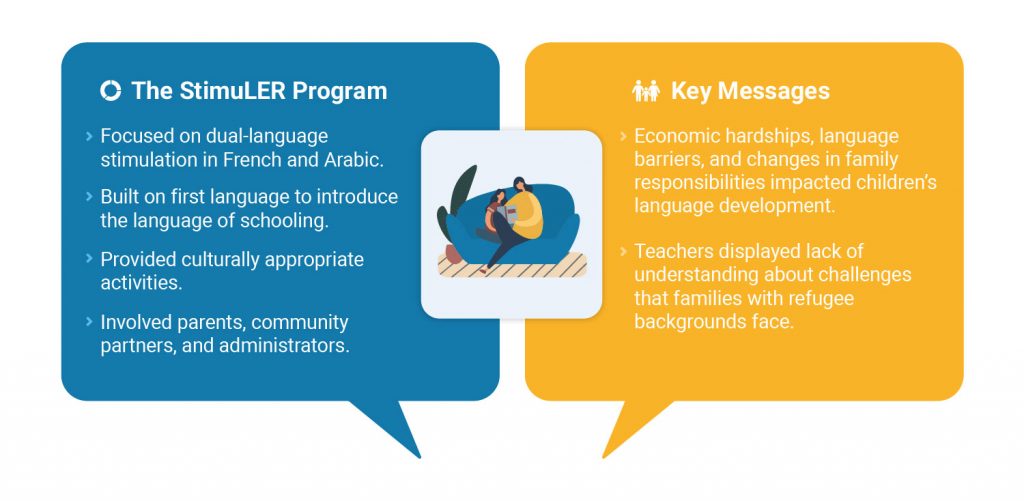The Effect of a Dual-language Stimulation Program for Refugee Children
Researchers: Andrea MacLeod1, Diane Pesco2, and Sylvana Côté3
Affiliation: University of Alberta1, Concordia University2, and Université de Montréal3
Keywords: Dual-language development, Syrian refugee children, preschool,early intervention, bilingual language abilities, Arabic, French
Jump to: Full Infographic, Methodology, Findings, Publications & Reports
Summary
Objective: This study aimed to develop and pilot an early intervention for refugee children that combined dual language support in Arabic and French with an evidence-based language-focused curriculum implemented by interdisciplinary teams. The intervention was evaluated for its effect on the dual language development, emergent literacy, and well-being of Syrian preschoolers who recently arrived in Montreal as refugees.
Justification: This study addresses concerns voiced by teachers working with Syrian refugee children in the researchers’ community; specifically concerns about the children’s language abilities in French, their first language development, and the overall well-being of these children in the classroom.
Practical goal: This study furthers our understanding of the impact of interventions that support the dual language acquisition of refugee children, and it produced a data-driven approach to supporting the language development of refugee children.
Primary audience: Educators, speech-language pathologists, and refugee parents
Infographic Excerpt

Methodology
Following a pre-pilot of the program, the intervention was held at a local school that welcomed a large number of Syrian refugees. The project focused on a group of six children who spoke Arabic as their first language, and were learning French, which was the language of schooling. In this group, three children who were Syrian refugees participated in the research project. This study employed quantitative measures, interviews, and observation. The participating children were assessed on well-being, including emotional regulation, via a questionnaire and interviews with parents and the intervention teachers. To assess children’s language development, observations and language sampling provided the primary data, while receptive vocabulary tests in French and Arabic were administered before the first intervention session and after the last session. The first and last intervention sessions were audio recorded and transcribed for: language spoken, speaker’s role (initiator or respondent), number of utterances, quality of utterances (single- or multi-word; word(s) taught or spontaneous), and the pragmatic function of turns (e.g., to achieve instrumental goal, comment on environment, interact socially, signal lack of understanding).
Findings
This study revealed a number of issues in refugee children’s dual language development: maintenance of the home language is difficult, particularly for children who arrive in Canada at a young age; collaboration between families and schools is challenging when budgets are tight and when families move to new communities; families may be unaware of services and supports available to children prior to entering school; and difficulties accessing these services and supports limit the potential for early interventions.
- The study produced an innovative early intervention program that focuses on dual-language stimulation, builds on first language knowledge to introduce the language of schooling, provides culturally-appropriate activities, and collaborates with school personnel, community organizations, and parents, involving them in their children’s learning process. Parents and teachers found the program helpful and supportive.
Explore more projects


